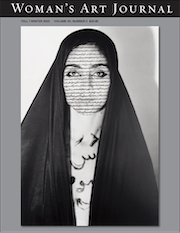 WAJ Home · Issue Contents · Editorial Board
WAJ Home · Issue Contents · Editorial Board
Subscription Info · Contributor Notes · Online Submissions · Recommend · Advertise in WAJ
Editorial Policies
Woman’s Art Journal, a semiannual periodical published in May and November, addresses women’s art heritage and contemporary issues as they relate to women. All submissions must be electronic and will be peer-reviewed by members of our editorial board and other scholars in the field. Authors must conform to our contributor’s Guidelines for text and images before making a submission. Once a manuscript is accepted, editing will be done electronically with coordination and cooperation between the editors and the author. Reviewers send their reviews electronically to the editors and all reviews undergo a similar editing process to that described above
Contributors receive five copies of the issue in which their article appears. WAJ is supported primarily by subscription sales. Authors are urged to subscribe to WAJ and to ask their institutions and colleagues to do the same. No material previously published in the English language will be accepted for publication. If an article has previously been published in another language, that information must be supplied. Requests to reproduce articles for classroom use are fulfilled unless the author indicates otherwise.
Manuscripts
Submissions should be approximately 15 pages (5,000–8,000 words), double-spaced, including endnotes where appropriate (follow The Chicago Manual of Style, 17th edition), in a readable format such as MS Word; authors are encouraged to submit up to 10 high-quality black and white or color jpegs. Articles are considered for publication in the order in which they are received. Please follow contributor guidelines below for endnote style and photographic materials. All manuscripts, proposals, or inquiries should be sent by email to aedelman@womansartjournal.org.
Portraits, Issues and Insights
Articles may deal with images and representations of women, proto-feminist and feminist interpretations of art history, feminist theory, and feminist critical analyses of global contemporary art and issues. Authors examine the lives and works of women in all areas of the visual arts and in multiple media from the remote or recent past and in the present —artists and artisans, designers, art historians and critics, museum curators and gallery directors, patrons, photographers, and architects.
Articles on individual women should focus on the subject’s biography as well as her work and should investigate how matters of gender and sexuality affected her life and practice. Articles on multiple women artists or thematic topics may consider how the histories and reception of ancient, pre-modern and modern women, proto-feminists, and contemporary feminists are visually, historically, and politically analyzed in a global context. Articles on the depiction of women by male artists will not be considered.
Book Reviews
WAJ publishes scholarly, disinterested reviews of recent books, collected volumes, and exhibition catalogues on one or more woman artists or on other feminist art-historical topics.
Our typical approximate word count for a review of one single-author book is 1,200-1,800 words; for a collected volume, including exhibition catalogues with contributions by multiple authors, 1,500-2,200; for two books on a single subject reviewed together, 1,800-2,600; and for three books on one subject, 2,200-3,200. Reviews are typically accompanied by one black-and-white illustration that does not require copyright permissions. Please see the full reviewer guidelines here.
To inquire about available books to review or to propose a specific single- or multi-book review, please contact book reviews editor Alison Poe at apoe@womansartjournal.org. You’ll receive a free copy of the book(s) you review.
Endnote Style
Follow The Chicago Manual of Style, 17th edition.
Examples
Whitney Chadwick and Tirza True Latimer, The Modern Woman Revisited: Paris Between the Wars (New Brunswick, NJ: Rutgers University Press, 2003), 4-5, 46-50, 127-45.
Elizabeth S. Cohen, “The Trials of Artemisia Gentileschi: A Rape as History,” in Sixteenth Century Journal 31 (2000): 47-75.
For subsequent references, use short title, e.g., Chadwick and Latimer, The Modern Woman Revisited, 6.
Cohen, “The Trials of Artemisia Gentileschi,” 61.
Use “ibid.” for citation immediately following original. Do not use “op. cit.” or “ff.”
Citations to Books Under Review
In reviews, include page number references to the book under review in parentheses within the sentence. For example, use this form either following “a quotation” (23), or wherever else a page citation in the book under review is needed (12).
Photographic Materials and Figures for Manuscripts
Visual materials must be submitted with the manuscript in a digital format along with a detailed list of figures. Upon acceptance of their article, authors are requested to obtain high resolution digital images for reproduction and secure copyright and permissions. WAJ does not financially support the acquisition of photographic materials. Authors are responsible for permission fees and are encouraged to apply for grants in support of color reproductions.
Formatting for Digital Files/Captions
Image files must be individually titled to include Fig. #, and brief title or description, e.g., Fig. 1_Kahlo_Heart_1937.jpg.
A separate caption list should include figure number, artist’s name, title of work, date, medium, size in inches, location (artist’s estate, museum or private collection), photo credit, courtesy, and copyright.
Examples
Fig. 1. Frida Kahlo, The Heart or Memory (1937), oil on canvas, 15 3/4″ x 11″. Private collection.
Fig. 2. Alice Trumbull Mason, Interference of Closed Forms (1945), soft ground etching and aquatint, 11 1/4″ x 13 1/4″. Private Collection. Photo: Gavin Ashworth. Courtesy of Washburn Gallery © 2022 Emily Mason |Alice Trumbull Mason Foundation/ARS.
Please contact Guy Griffiths at Old City Publishing to request production requirements (email; phone +1 215 925 4390).
